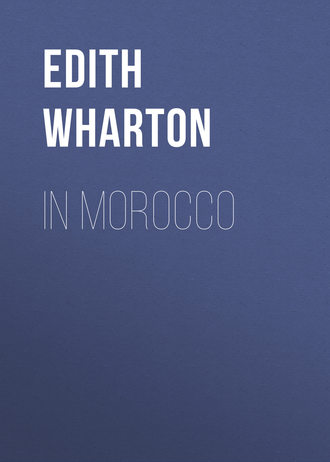 полная версия
полная версияIn Morocco
IV
ALMORAVIDS AND ALMOHADS
While the Hilalian Arabs were conquering and destroying northern Morocco another but more fruitful invasion was upon her from the south. The Almoravids, one of the tribes of Veiled Men of the south, driven by the usual mixture of religious zeal and lust of booty, set out to invade the rich black kingdoms north of the Sahara. Thence they crossed the Atlas under their great chief, Youssef-ben-Tachfin, and founded the city of Marrakech in 1062. From Marrakech they advanced on Idrissite Fez and the valley of the Moulouya. Fez rose against her conquerors, and Youssef put all the male inhabitants to death. By 1084 he was master of Tangier and the Rif, and his rule stretched as far west as Tlemcen, Oran and finally Algiers.
His ambition drove him across the straits to Spain, where he conquered one Moslem prince after another and wiped out the luxurious civilization of Moorish Andalusia. In 1086, at Zallarca, Youssef gave battle to Alphonso VI of Castile and Leon. The Almoravid army was a strange rabble of Arabs, Berbers, blacks, wild tribes of the Sahara and Christian mercenaries. They conquered the Spanish forces, and Youssef left to his successors an empire extending from the Ebro to Senegal and from the Atlantic coast of Africa to the borders of Tunisia. But the empire fell to pieces of its own weight, leaving little record of its brief and stormy existence. While Youssef was routing the forces of Christianity at Zallarca in Spain, another schismatic tribe of his own people was detaching Marrakech and the south from his rule.
The leader of the new invasion was a Mahdi, one of the numerous Saviours of the World who have carried death and destruction throughout Islam. His name was Ibn-Toumert, and he had travelled in Egypt, Syria and Spain, and made the pilgrimage to Mecca. Preaching the doctrine of a purified monotheism, he called his followers the Almohads or Unitarians, to distinguish them from the polytheistic Almoravids, whose heresies he denounced. He fortified the city of Tinmel in the Souss, and built there a mosque of which the ruins still exist. When he died, in 1128, he designated as his successor Abd-el-Moumen, the son of a potter, who had been his disciple.
Abd-el-Moumen carried on the campaign against the Almoravids. He fought them not only in Morocco but in Spain, taking Cadiz, Cordova, Granada as well as Tlemcen and Fez. In 1152 his African dominion reached from Tripoli to the Souss, and he had formed a disciplined army in which Christian mercenaries from France and Spain fought side by side with Berbers and Soudanese. This great captain was also a great administrator, and under his rule Africa was surveyed from the Souss to Barka, the country was policed, agriculture was protected, and the caravans journeyed safely over the trade-routes.
Abd-el-Moumen died in 1163 and was followed by his son, who, though he suffered reverses in Spain, was also a great ruler. He died in 1184, and his son, Yacoub-el-Mansour, avenged his father's ill-success in Spain by the great victory of Alarcos and the conquest of Madrid. Yacoub-el-Mansour was the greatest of Moroccan Sultans. So far did his fame extend that the illustrious Saladin sent him presents and asked the help of his fleet. He was a builder as well as a fighter, and the noblest period of Arab art in Morocco and Spain coincides with his reign.
After his death, the Almohad empire followed the downward curve to which all Oriental rule seems destined. In Spain, the Berber forces were beaten in the great Christian victory of Las-Navas-de Tolosa; and in Morocco itself the first stirrings of the Beni-Merins (a new tribe from the Sahara) were preparing the way for a new dynasty.
V
THE MERINIDS
The Beni-Merins or Merinids were nomads who ranged the desert between Biskra and the Tafilelt. It was not a religious upheaval that drove them to the conquest of Morocco. The demoralized Almohads called them in as mercenaries to defend their crumbling empire; and the Merinids came, drove out the Almohads, and replaced them.
They took Fez, Meknez, Salé, Rabat and Sidjilmassa in the Tafilelt; and their second Sultan, Abou-Youssef, built New Fez (Eldjid) on the height above the old Idrissite city. The Merinids renewed the struggle with the Sultan of Tlemcen, and carried the Holy War once more into Spain. The conflict with Tlemcen was long and unsuccessful, and one of the Merinid Sultans died assassinated under its walls. In the fourteenth century the Sultan Abou Hassan tried to piece together the scattered bits of the Almohad empire. Tlemcen was finally taken, and the whole of Algeria annexed. But in the plain of Kairouan, in Tunisia, Abou Hassan was defeated by the Arabs. Meanwhile one of his brothers had headed a revolt in Morocco, and the princes of Tlemcen won back their ancient kingdom. Constantine and Bougie rebelled in turn, and the kingdom of Abou Hassan vanished like a mirage. His successors struggled vainly to control their vassals in Morocco, and to keep their possessions beyond its borders. Before the end of the fourteenth century Morocco from end to end was a chaos of antagonistic tribes, owning no allegiance, abiding by no laws. The last of the Merinids, divided, diminished, bound by humiliating treaties with Christian Spain, kept up a semblance of sovereignty at Fez and Marrakech, at war with one another and with their neighbours; and Spain and Portugal seized this moment of internal dissolution to drive them from Spain, and carry the war into Morocco itself.
The short and stormy passage of the Beni-Merins seems hardly to leave room for the development of the humaner qualities; yet the flowering of Moroccan art and culture coincided with those tumultuous years, and it was under the Merinid Sultans that Fez became the centre of Moroccan learning and industry, a kind of Oxford with Birmingham annexed.
VI
THE SAADIANS
Meanwhile, behind all the Berber turmoil a secret work of religious propaganda was going on. The Arab element had been crushed but not extirpated. The crude idolatrous wealth-loving Berbers apparently dominated; but whenever there was a new uprising or a new invasion it was based on the religious discontent perpetually stirred up by Mahometan agents. The longing for a Mahdi, a Saviour, the craving for purification combined with an opportunity to murder and rob, always gave the Moslem apostle a ready opening; and the downfall of the Merinids was the result of a long series of religious movements to which the European invasion gave an object and a war-cry.
The Saadians were Cherifian Arabs, newcomers from Arabia, to whom the lax Berber paganism was abhorrent. They preached a return to the creed of Mahomet, and proclaimed the Holy War against the hated Portuguese, who had set up fortified posts all along the west coast of Morocco.
It is a mistake to suppose that hatred of the Christian has always existed among the North African Moslems. The earlier dynasties, and especially the great Almohad Sultans, were on friendly terms with the Catholic powers of Europe, and in the thirteenth century a treaty assured to Christians in Africa full religious liberty, excepting only the right to preach their doctrine in public places. There was a Catholic diocese at Fez, and afterward at Marrakech under Gregory IX, and there is a letter of the Pope thanking the "Miromilan" (the Emir El Moumenin) for his kindness to the Bishop and the friars living in his dominions. Another Bishop was recommended by Innocent IV to the Sultan of Morocco; the Pope even asked that certain strongholds should be assigned to the Christians in Morocco as places of refuge in times of disturbance. But the best proof of the friendly relations between Christians and infidels is the fact that the Christian armies which helped the Sultans of Morocco to defeat Spain and subjugate Algeria and Tunisia were not composed of "renegadoes" or captives, as is generally supposed, but of Christian mercenaries, French and English, led by knights and nobles, and fighting for the Sultan of Morocco exactly as they would have fought for the Duke of Burgundy, the Count of Flanders, or any other Prince who offered high pay and held out the hope of rich spoils. Any one who has read "Villehardouin" and "Joinville" will own that there is not much to choose between the motives animating these noble freebooters and those which caused the Crusaders to loot Constantinople "on the way" to the Holy Sepulchre. War in those days was regarded as a lucrative and legitimate form of business, exactly as it was when the earlier heroes started out to take the rich robber-town of Troy.
The Berbers have never been religious fanatics, and the Vicomte de Foucauld, when he made his great journey of exploration in the Atlas in 1883, remarked that antagonism to the foreigner was always due to the fear of military espionage and never to religious motives. This equally applies to the Berbers of the sixteenth century, when the Holy War against Catholic Spain and Portugal was preached. The real cause of the sudden deadly hatred of the foreigner was twofold. The Spaniards were detested because of the ferocious cruelty with which they had driven the Moors from Spain under Ferdinand and Isabella; and the Portuguese because of the arrogance and brutality of their military colonists in the fortified trading stations of the west coast. And both were feared as possible conquerors and overlords.
There was a third incentive also: the Moroccans, dealing in black slaves for the European market, had discovered the value of white slaves in Moslem markets. The Sultan had his fleet, and each coast-town its powerful pirate vessels, and from pirate-nests like Salé and Tangier the raiders continued, till well on into the first half of the nineteenth century, to seize European ships and carry their passengers to the slave-markets of Fez and Marrakech.24 The miseries endured by these captives, and so poignantly described in John Windus's travels, and in the "Naufrage du Brick Sophie" by Charles Cochelet,25 show how savage the feeling against the foreigner had become.
With the advent of the Cherifian dynasties, which coincided with this religious reform, and was in fact brought about by it, Morocco became a closed country, as fiercely guarded as Japan against European penetration. Cut off from civilizing influences, the Moslems isolated themselves in a lonely fanaticism, far more racial than religious, and the history of the country from the fall of the Merinids till the French annexation is mainly a dull tale of tribal warfare.
The religious movement of the sixteenth century was led and fed by zealots from the Sahara. One of them took possession of Rabat and Azemmour, and preached the Holy War; other "feudal fiefs" (as M. Augustin Bernard has well called them) were founded at Tameslout, Ilegh, Tamgrout: the tombs of the marabouts who led these revolts are scattered all along the west coast, and are still objects of popular veneration. The unorthodox saint worship which marks Moroccan Moslemism, and is commemorated by the countless white koubbas throughout the country, grew up chiefly at the time of the religious revival under the Saadian dynasty, and almost all the "Moulays" and "Sidis" venerated between Tangier and the Atlas were warrior monks who issued forth from their fortified Zaouïas to drive the Christians out of Africa.
The Saadians were probably rather embarrassed by these fanatics, whom they found useful to oppose to the Merinids, but troublesome where their own plans were concerned. They were ambitious and luxury-loving princes, who invaded the wealthy kingdom of the Soudan, conquered the Sultan of Timbuctoo, and came back laden with slaves and gold to embellish Marrakech and spend their treasure in the usual demoralizing orgies. Their exquisite tombs at Marrakech commemorate in courtly language the superhuman virtues of a series of rulers whose debaucheries and vices were usually cut short by assassination. Finally another austere and fanatical mountain tribe surged down on them, wiped them out, and ruled in their stead.
VII
THE HASSANIANS
The new rulers came from the Tafilelt, which has always been a troublesome corner of Morocco. The first two Hassanian Sultans were the usual tribal chiefs bent on taking advantage of Saadian misrule to loot and conquer. But the third was the great Moulay-Ismaël, the tale of whose long and triumphant rule (1672 to 1727) has already been told in the chapter on Meknez. This savage and enlightened old man once more drew order out of anarchy, and left, when he died, an organized and administered empire, as well as a progeny of seven hundred sons and unnumbered daughters.26
The empire fell apart as usual, and no less quickly than usual, under his successors; and from his death until the strong hand of General Lyautey took over the direction of affairs the Hassanian rule in Morocco was little more than a tumult of incoherent ambitions. The successors of Moulay-Ismaël inherited his blood-lust and his passion for dominion without his capacity to govern. In 1757 Sidi-Mohammed, one of his sons, tried to put order into his kingdom, and drove the last Portuguese out of Morocco; but under his successors the country remained isolated and stagnant, making spasmodic efforts to defend itself against the encroachments of European influence, while its rulers wasted their energy in a policy of double-dealing and dissimulation. Early in the nineteenth century the government was compelled by the European powers to suppress piracy and the trade in Christian slaves; and in 1830 the French conquest of Algeria broke down the wall of isolation behind which the country was mouldering away by placing a European power on one of its frontiers.
At first the conquest of Algeria tended to create a link between France and Morocco. The Dey of Algiers was a Turk, and, therefore, an hereditary enemy; and Morocco was disposed to favour the power which had broken Turkish rule in a neighbouring country. But the Sultan could not help trying to profit by the general disturbance to seize Tlemcen and raise insurrections in western Algeria; and presently Morocco was engaged in a Holy War against France. Abd-el-Kader, the Sultan of Algeria, had taken refuge in Morocco, and the Sultan of Morocco having furnished him with supplies and munitions, France sent an official remonstrance. At the same time Marshal Bugeaud landed at Mers-el-Kebir, and invited the Makhzen to discuss the situation. The offer was accepted and General Bedeau and the Caïd El Guennaoui met in an open place. Behind them their respective troops were drawn up, and almost as soon as the first salutes were exchanged the Caïd declared the negotiations broken off. The French troops accordingly withdrew to the coast, but during their retreat they were attacked by the Moroccans. This put an end to peaceful negotiations, and Tangier was besieged and taken. The following August Bugeaud brought his troops up from Oudjda, through the defile that leads from West Algeria, and routed the Moroccans. He wished to advance on Fez, but international politics interfered, and he was not allowed to carry out his plans. England looked unfavourably on the French penetration of Morocco, and it became necessary to conclude peace at once to prove that France had no territorial ambitions west of Oudjda.
Meanwhile a great Sultan was once more to appear in the land. Moulay-el-Hassan, who ruled from 1873 to 1894, was an able and energetic administrator. He pieced together his broken empire, asserted his authority in Fez and Marrakech, and fought the rebellious tribes of the west. In 1877 he asked the French government to send him a permanent military mission to assist in organizing his army. He planned an expedition to the Souss, but the want of food and water in the wilderness traversed by the army caused the most cruel sufferings. Moulay-el-Hassan had provisions sent by sea, but the weather was too stormy to allow of a landing on the exposed Atlantic coast, and the Sultan, who had never seen the sea, was as surprised and indignant as Canute to find that the waves would not obey him.
His son Abd-el-Aziz was only thirteen years old when he succeeded to the throne. For six years he remained under the guardianship of Ba-Ahmed, the black Vizier of Moulay-el-Hassan, who built the fairy palace of the Bahia at Marrakech, with its mysterious pale green padlocked door leading down to the secret vaults where his treasure was hidden. When the all-powerful Ba-Ahmed died the young Sultan was nineteen. He was intelligent, charming, and fond of the society of Europeans; but he was indifferent to religious questions and still more to military affairs, and thus doubly at the mercy of native mistrust and European intrigue.
Some clumsy attempts at fiscal reform, and a too great leaning toward European habits and associates, roused the animosity of the people, and of the conservative party in the upper class. The Sultan's eldest brother, who had been set aside in his favour, was intriguing against him; the usual Cherifian Pretender was stirring up the factious tribes in the mountains; and the European powers were attempting, in the confusion of an ungoverned country, to assert their respective ascendencies.
The demoralized condition of the country justified these attempts, and made European interference inevitable. But the powers were jealously watching each other, and Germany, already coveting the certain agricultural resources and the conjectured mineral wealth of Morocco, was above all determined that a French protectorate should not be set up.
In 1908 another son of Moulay-Hassan, Abd-el-Hafid, was proclaimed Sultan by the reactionary Islamite faction, who accused Abd-el-Aziz of having sold his country to the Christians. Abd-el-Aziz was defeated in a battle near Marrakech, and retired to Tangier, where he still lives in futile state. Abd-el-Hafid, proclaimed Sultan at Fez, was recognized by the whole country; but he found himself unable to cope with the factious tribes (those outside the Blad-el-Makhzen, or governed country). These rebel tribes besieged Fez, and the Sultan had to ask France for aid. France sent troops to his relief, but as soon as the dissidents were routed, and he himself was safe, Abd-el-Hafid refused to give the French army his support, and in 1912, after the horrible massacres of Fez, he abdicated in favour of another brother, Moulay Youssef, the actual ruler of Morocco.
FOOTNOTES:
VIII
NOTE ON MOROCCAN ARCHITECTURE
I
M. H. Saladin, whose "Manual of Moslem Architecture" was published in 1907, ends his chapter on Morocco with the words: "It is especially urgent that we should know, and penetrate into, Morocco as soon as possible, in order to study its monuments. It is the only country but Persia where Moslem art actually survives; and the tradition handed down to the present day will doubtless clear up many things."
M. Saladin's wish has been partly realized. Much has been done since 1912, when General Lyautey was appointed Resident-General, to clear up and classify the history of Moroccan art; but since 1914, though the work has never been dropped, it has necessarily been much delayed, especially as regards its published record; and as yet only a few monographs and articles have summed up some of the interesting investigations of the last five years.
II
When I was in Marrakech word was sent to Captain de S., who was with me, that a Caïd of the Atlas, whose prisoner he had been several years before, had himself been taken by the Pasha's troops, and was in Marrakech. Captain de S. was asked to identify several rifles which his old enemy had taken from him, and on receiving them found that, in the interval, they had been elaborately ornamented with the Arab niello work of which the tradition goes back to Damascus.
This little incident is a good example of the degree to which the mediæval tradition alluded to by M. Saladin has survived in Moroccan life. Nowhere else in the world, except among the moribund fresco-painters of the Greek monasteries, has a formula of art persisted from the seventh or eighth century to the present day; and in Morocco the formula is not the mechanical expression of a petrified theology but the setting of the life of a people who have gone on wearing the same clothes, observing the same customs, believing in the same fetiches, and using the same saddles, ploughs, looms, and dye-stuffs as in the days when the foundations of the first mosque of El Kairouiyin were laid.
The origin of this tradition is confused and obscure. The Arabs have never been creative artists, nor are the Berbers known to have been so. As investigations proceed in Syria and Mesopotamia it seems more and more probable that the sources of inspiration of pre-Moslem art in North Africa are to be found in Egypt, Persia, and India. Each new investigation pushes these sources farther back and farther east; but it is not of much use to retrace these ancient vestiges, since Moroccan art has, so far, nothing to show of pre-Islamite art, save what is purely Phenician or Roman.
In any case, however, it is not in Morocco that the clue to Moroccan art is to be sought; though interesting hints and mysterious reminiscences will doubtless be found in such places as Tinmel, in the gorges of the Atlas, where a ruined mosque of the earliest Almohad period has been photographed by M. Doutté, and in the curious Algerian towns of Sedrata and the Kalaa of the Beni Hammads. Both of these latter towns were rich and prosperous communities in the tenth century and both were destroyed in the eleventh, so that they survive as mediæval Pompeiis of a quite exceptional interest, since their architecture appears to have been almost unaffected by classic or Byzantine influences.
Traces of a very old indigenous art are found in the designs on the modern white and black Berber pottery; but this work, specimens of which are to be seen in the Oriental Department of the Louvre, seems to go back, by way of Central America, Greece (sixth century b. c.) and Susa (twelfth century b. c.), to the far-off period before the streams of human invention had divided, and when the same loops and ripples and spirals formed on the flowing surface of every current.
It is a disputed question whether Spanish influence was foremost in developing the peculiarly Moroccan art of the earliest Moslem period, or whether European influences came by way of Syria and Palestine, and afterward met and were crossed with those of Moorish Spain. Probably both things happened, since the Almoravids were in Spain; and no doubt the currents met and mingled. At any rate, Byzantine, Greece, and the Palestine and Syria of the Crusaders, contributed as much as Rome and Greece to the formation of that peculiar Moslem art which, all the way from India to the Pillars of Hercules, built itself, with minor variations, out of the same elements.
Arab conquerors always destroy as much as they can of the work of their predecessors, and nothing remains, as far as is known, of Almoravid architecture in Morocco. But the great Almohad Sultans covered Spain and Northwest Africa with their monuments, and no later buildings in Africa equal them in strength and majesty.
It is no doubt because the Almohads built in stone that so much of what they made survives. The Merinids took to rubble and a soft tufa, and the Cherifian dynasties built in clay like the Spaniards in South America. And so seventeenth century Meknez has perished while the Almohad walls and towers of the tenth century still stand.
The principal old buildings of Morocco are defensive and religious—and under the latter term the beautiful collegiate houses (the medersas) of Fez and Salé may fairly be included, since the educational system of Islam is essentially and fundamentally theological. Of old secular buildings, palaces or private houses, virtually none are known to exist; but their plan and decorations may easily be reconstituted from the early chronicles, and also from the surviving palaces built in the eighteenth and nineteenth centuries, and even those which the wealthy nobles of modern Morocco are building to this day.
The whole of civilian Moslem architecture from Persia to Morocco is based on four unchanging conditions: a hot climate, slavery, polygamy and the segregation of women. The private house in Mahometan countries is in fact a fortress, a convent and a temple: a temple of which the god (as in all ancient religions) frequently descends to visit his cloistered votaresses. For where slavery and polygamy exist every house-master is necessarily a god, and the house he inhabits a shrine built about his divinity.









